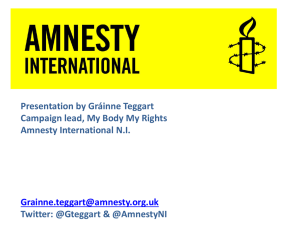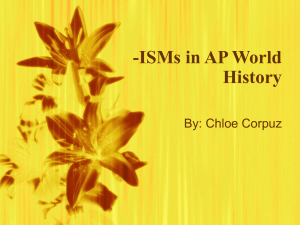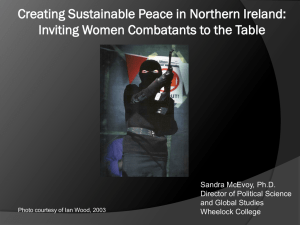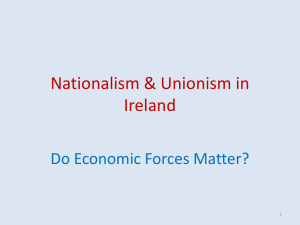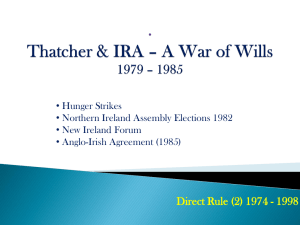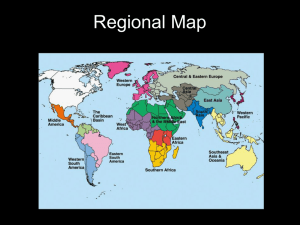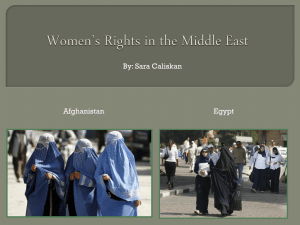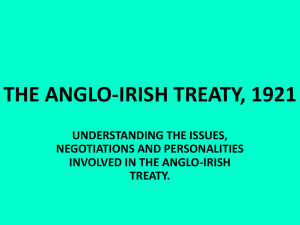(Religion and Conflict).
advertisement
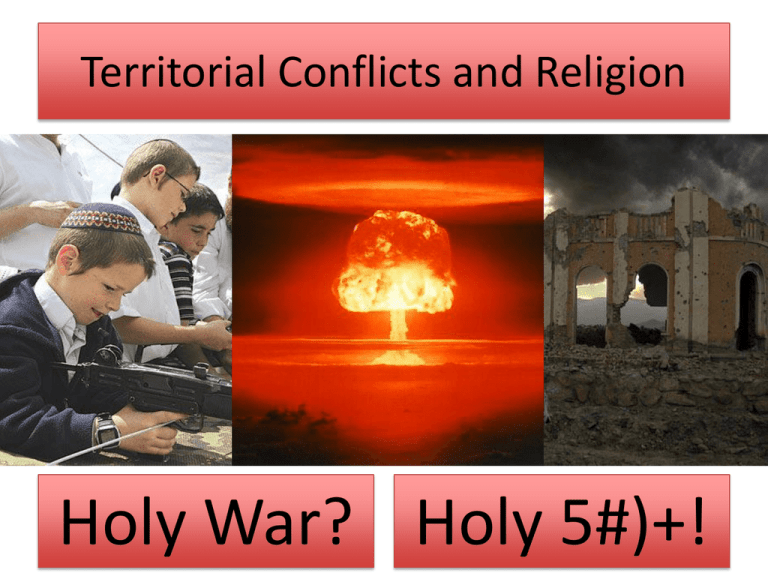
Territorial Conflicts and Religion Holy War? Holy 5#)+! CONFLICT The 20th century was an era of global conflict With the end of the cold war, the threat of global conflict has receded. Local conflicts have increased, however, in areas of cultural plurality. Religion is an element of culture that often leads to local conflict, especially along inter- and intrafaith boundaries. The spatial expression of one religion can often come into conflict with that of another. RELIGION VS. GOVERNMENT Religious groups may oppose government policies that seem to promote social change that conflicts with traditional religious values. RELIGION VS. SOCIAL CHANGE TALIBAN VS. WESTERN VALUES The Taliban (translates as “the disciples”) took power in Afghanistan in 1996. The Taliban had run local religions schools since Islam came to Afghanistan in the 7th century CE. Locals preferred them to the corruption of the prior government; the US as a strong opposition to Russia. Once in control, they instituted Shariah law (Islamic law) interpreted by their own strict views, enforced by the Ministry for the Promotion of Virtue and the Prevention of Vice. They banned un-Islamic activities like western music, flying kites, television and the internet. They converted soccer stadiums to arenas for public floggings and executions. Men were beaten for shaved beards and women were stoned from committing adultery. Homosexuals were buried alive, prostitutes were hung. Thieves had hands cut off and women wearing nail polish had fingers cut off. In 2001, Taliban forces set out to destroy enormous Buddhist statues carved at Bamiyan in the 2nd century CE. Islamic scholars denounced the Taliban as poorly educated in their understanding of the Qur’an and Islamic Law and History. In 2001, the US invaded Afghanistan, overthrew the Taliban and installed a new government, but Taliban has regrouped and resumed fighting. RELIGION VS. SOCIAL CHANGE HINDUISM VS. SOCIAL EQUALITY Traditional Hindu values have been under pressure since the British colonized India in the 1800s. Particularly under attack was the caste system. When Aryan invaders came to India c.1500 BCE, they brought with them a rigid, four tier caste system. The Aryans reserved the four tiers for themselves, conquered the indigenous Harappan civilization and made them a fifth tier (harijans/dalits… the untouchables). Over the centuries, these castes (Varnas) have broken into thousand of subcastes (jatis), and the castes were kept segregated in almost all aspects of life. India officially abolished the untouchable caste and gave them rights equal to other castes. However, social awareness of castes still persists. GOVERNMENT VS. RELIGION According to Karl Marx, “The abolition of religion as the illusory happiness of the people is required for their real happiness.” Therefore, Communist governments have often sought to abolish religion in their realms, especially Orthodox Christianity, Islam and Buddhism in Eastern Europe and Asia. ORTHODOX CHRISTIANTY AND ISLAM V. USSR In 1721 Peter the Great linked the Russian Orthodox Church to the government. The Patriarch of the church was replaced by a 12 member Synod appointed by the czar. After the Bolshevik Revolution in 1917, the Soviet communist government pursued antireligious policies (eliminated church-state link in 1918). All church buildings and property were nationalized and run by the gov. Some churches were used for secular purposes. Other churches remained open, but religion was not encouraged and attendance dropped sharply. The fall of communism in the late 1900s brought a religious revival. Property reverted to church ownership and attendance at religious services increased. Former Soviet Republics in Central Asia were mostly Muslim: Kazakhstan, Kyrgyzstan, Tajikistan, Turkmenistan, Uzbekistan. These countries are now trying to determine the degree to which religions will figure in their legal systems Just a reminder: that smaller region to the left is the Caucasus region, and it’s considered a shatterbelt because the national boundaries don’t map onto the cultural boundaries. GOVERNMENT V. RELIGION BUDDHISM V. SOUTHEAST ASIAN COMMUNISM Buddhism came into conflict during the Vietnam wars (both the French and US iterations). Neither the communists, the French nor the US were particularly sensitive to Buddhist peoples or interests. US air raids destroyed many Buddhist shrines in Laos and Cambodia, Vietnamese and Cambodians communists vandalized others. A number of Buddhist monks immolated themselves in protest of various policies by both entities. Communist China annexed Tibet and suppressed Buddhism in Tibet and China, killing thousands of monks and causing the Dalai Lama to flee to India. The military junta that seized Burma and renamed it Myanmar has also suppressed Buddhism there. Angkor Wat in Cambodia Current communist governments in SE Asia discourage religious activities and allow many structures to decay. RELIGION vs. RELIGION Religious conflicts are most likely to occur along boundary lines between two religions on two branches/denominations of one religion. Interfaith boundary: the boundary line between regions where two separate religions are the majority. Intrafaith boundary: the boundary line between two different branches or denominations of a single religions. Religious fundamentalism also often causes or intensifies religious conflict. Fundamentalism: a form of a given religion that espouses a literal reading of the scripture and strict adherence to religious doctrine and dogma. Doctrine: any official teaching/tenet of a religious group, whereas dogma usually refers to the entire body of doctrine. Many groups see fundamentalism as the only way a religion can defend itself against globalism of culture and economy. Catholics riot during Protestant parade in Ireland RELIGION vs. RELIGION Religious Wars in Ireland A small To the north number andofeast Catholics of the island in bothofthe England Republic liesof the Ireland islandand of Eire. Northern Ireland decided to join the Irish Republican Army (IRA), a militant group of The Republic Irish nationalists of Ireland dedicated occupies to achieving the southern Irish national 5/6 of the unity island by whatever and is 87% Catholic. means necessary The northern (including 1/6 of violence). the island belongs to the United Kingdom and is 46% Protest and 40% Catholic. Their goal is to bring Northern Ireland into the Republic of Ireland. All of the island was a British colony for centuries and was made a part of the UKProtestants Some in 1801. in Northern Irelandthen decided to formmilitant groups of their own, like the Ulster Defense Force (UDF). Irish agitators pushed for independence throughout the 1800s, and in 1921, it becamethe Although a self-governing majority of people dominion in both within branches the UK. in Northern Ireland are willing to live peacefully, extremists in both groups disrupt life and often also Ireland get elected declared into office. independence in 1937 and created itself as a republic in 1949. Violence will continue as long at Protestants and Catholics remain When Ireland committed to declared their separate independence, causes. the majority Protestant population in six northern counties voted to remain in the UK (which was itself predominantly Protestant) rather than be in the predominantly Catholic Republic of Ireland. Since that point, Cathlics in Northern Ireland have often been discriminated against and excluded from jobs and schools. Catholics in Northern Ireland began protests in 1968, and since then more than 3000 Catholics and Protestants have been killed in clashes. RELIGION vs. RELIGION Religious Wars in the Middle East Jews, Christians and Muslims have been fighting for 2,000 to control the same small strip of land on the Mediterranean coast. All three groups trace their origins to Abraham and the narrative of the Hebrew Bible in Genesis, and all three religions have ties to the same geographic area. Judaism: An ethnic religion that makes a special claim to the “Promised Land” that modern day Israel encompasses. Judaism’s religious calendar is based on the agricultural cycle in Israel. Jews were driven out of the area after the Romans burnt the temple In Jerusalem in 70AD. (Romans called the area Palestine.) Christianity: considers Palestine the Holy Land and Jerusalem the ‘Holy City” because of the land and the city’s ties to the life, death and resurrection of Jesus. Most inhabitants of the area became Christian when Christianity became the official religion of the Roman Empire with Theodosius in 380AD. Islam: Became the dominant religion in Palestine when the Muslim army conquered the area in 7th century AD. Jerusalem is a holy city in Islam because Muhammad was said to have ascended into heaven from the Temple Mount there. RELIGION vs. RELIGION Religious Wars in the Middle East The Crusades The Crusades were a series of conflicts between Christians and Muslims fighting for control of Palestine. In 7th century AD, armies from the Arabian Peninsula (Arabs) captured most of the middle east, including Palestine. Most people in the Middle East subsequently became Arabic speaking Muslims. The Arab armies moved west across northern Africa, crossed the strait of Gibraltar and invaded Europe through Spain in 711. The Arabs conquered most of the Iberian peninsula and then crossed the Pyrenees into France. Charles Martel stopped the Arab advances at Poitiers, France in 732. Arabs controlled Spain until 1492. Ottomon Turks captured Ocnstantinople, the capita of the Eastern Roman Empire in 1453 and spread into Eastern Europe as far as BosniaHerzegovina. To recapture the Holy Land, European Christians launched a series of campaigns spanning 150 years, winning and losing Jerusalem many times during the years. RELIGION vs. RELIGION Religious Wars in the Middle East Jews v. Muslims The Ottoman Empire controlled Palestine from 1516 to 1917 when it was defeated in WWI and Great Britain took control of the area. Zionism is the philosophy that supports the world Jewry’s right to possess, inhabit and govern the biblical land of Israel. The British allowed some Jews to migrate to Palestine, but then restricted immigration under pressure from Arab groups. In 1947, The UN voted to partition Palestine into two independent states, one Jewish and one Muslim with Jerusalem to be an international city. The British withdrew from Palestine in 1948, the Jews declared an independent state of Israel according to the UN resolution, and the neighboring Arab Muslim states declared war. In 1949, the combatants signed an armistice, re-dividing the area. Israel then won three separate wars in the region in 1956, 1967 and 1973. The most important of which was the 1967 war. Please read carefully: the sections in your book on the Palestinian and Israeli perspectives on the conflict. Terms: PLO, Palestinian Authority, Fatah, Hamas, West Bank, Gaza Strip, Golan Heights
